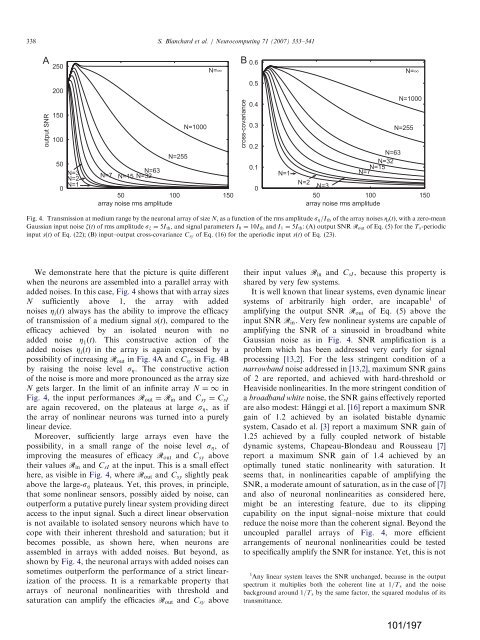a la physique de l'information - Lisa - Université d'Angers
a la physique de l'information - Lisa - Université d'Angers
a la physique de l'information - Lisa - Université d'Angers
You also want an ePaper? Increase the reach of your titles
YUMPU automatically turns print PDFs into web optimized ePapers that Google loves.
338<br />
output SNR<br />
250<br />
200<br />
150<br />
100<br />
50<br />
N=3<br />
N=2<br />
N=1<br />
0<br />
N=7<br />
N=63<br />
N=15 N=32<br />
N=255<br />
50 100 150<br />
array noise rms amplitu<strong>de</strong><br />
We <strong>de</strong>monstrate here that the picture is quite different<br />
when the neurons are assembled into a parallel array with<br />
ad<strong>de</strong>d noises. In this case, Fig. 4 shows that with array sizes<br />
N sufficiently above 1, the array with ad<strong>de</strong>d<br />
noises Z iðtÞ always has the ability to improve the efficacy<br />
of transmission of a medium signal sðtÞ, compared to the<br />
efficacy achieved by an iso<strong>la</strong>ted neuron with no<br />
ad<strong>de</strong>d noise Z 1ðtÞ. This constructive action of the<br />
ad<strong>de</strong>d noises Z iðtÞ in the array is again expressed by a<br />
possibility of increasing Rout in Fig. 4A and Csy in Fig. 4B<br />
by raising the noise level sZ. The constructive action<br />
of the noise is more and more pronounced as the array size<br />
N gets <strong>la</strong>rger. In the limit of an infinite array N ¼1 in<br />
Fig. 4, the input performances Rout ¼ Rin and Csy ¼ CsI<br />
are again recovered, on the p<strong>la</strong>teaus at <strong>la</strong>rge sZ, as if<br />
the array of nonlinear neurons was turned into a purely<br />
linear <strong>de</strong>vice.<br />
Moreover, sufficiently <strong>la</strong>rge arrays even have the<br />
possibility, in a small range of the noise level sZ, of<br />
improving the measures of efficacy Rout and Csy above<br />
their values Rin and CsI at the input. This is a small effect<br />
here, as visible in Fig. 4, where Rout and Csy slightly peak<br />
above the <strong>la</strong>rge-sZ p<strong>la</strong>teaus. Yet, this proves, in principle,<br />
that some nonlinear sensors, possibly ai<strong>de</strong>d by noise, can<br />
outperform a putative purely linear system providing direct<br />
access to the input signal. Such a direct linear observation<br />
is not avai<strong>la</strong>ble to iso<strong>la</strong>ted sensory neurons which have to<br />
cope with their inherent threshold and saturation; but it<br />
becomes possible, as shown here, when neurons are<br />
assembled in arrays with ad<strong>de</strong>d noises. But beyond, as<br />
shown by Fig. 4, the neuronal arrays with ad<strong>de</strong>d noises can<br />
sometimes outperform the performance of a strict linearization<br />
of the process. It is a remarkable property that<br />
arrays of neuronal nonlinearities with threshold and<br />
saturation can amplify the efficacies Rout and Csy above<br />
ARTICLE IN PRESS<br />
S. B<strong>la</strong>nchard et al. / Neurocomputing 71 (2007) 333–341<br />
N=1000<br />
N=∞<br />
cross-covariance<br />
0.6<br />
0.5<br />
0.4<br />
0.3<br />
0.2<br />
0.1<br />
0<br />
N=1<br />
N=2<br />
N=3<br />
N=255<br />
N=15<br />
N=32<br />
N=63<br />
N=7<br />
N=∞<br />
N=1000<br />
50 100 150<br />
array noise rms amplitu<strong>de</strong><br />
Fig. 4. Transmission at medium range by the neuronal array of size N, as a function of the rms amplitu<strong>de</strong> sZ=I th of the array noises Z iðtÞ, with a zero-mean<br />
Gaussian input noise xðtÞ of rms amplitu<strong>de</strong> sx ¼ 5I th, and signal parameters I 0 ¼ 10I th and I 1 ¼ 5I th: (A) output SNR Rout of Eq. (5) for the T s-periodic<br />
input sðtÞ of Eq. (22); (B) input–output cross-covariance Csy of Eq. (16) for the aperiodic input sðtÞ of Eq. (23).<br />
their input values Rin and CsI, because this property is<br />
shared by very few systems.<br />
It is well known that linear systems, even dynamic linear<br />
systems of arbitrarily high or<strong>de</strong>r, are incapable 1 of<br />
amplifying the output SNR Rout of Eq. (5) above the<br />
input SNR Rin. Very few nonlinear systems are capable of<br />
amplifying the SNR of a sinusoid in broadband white<br />
Gaussian noise as in Fig. 4. SNR amplification is a<br />
problem which has been addressed very early for signal<br />
processing [13,2]. For the less stringent condition of a<br />
narrowband noise addressed in [13,2], maximum SNR gains<br />
of 2 are reported, and achieved with hard-threshold or<br />
Heavisi<strong>de</strong> nonlinearities. In the more stringent condition of<br />
a broadband white noise, the SNR gains effectively reported<br />
are also mo<strong>de</strong>st: Ha¨nggi et al. [16] report a maximum SNR<br />
gain of 1.2 achieved by an iso<strong>la</strong>ted bistable dynamic<br />
system, Casado et al. [3] report a maximum SNR gain of<br />
1.25 achieved by a fully coupled network of bistable<br />
dynamic systems, Chapeau-Blon<strong>de</strong>au and Rousseau [7]<br />
report a maximum SNR gain of 1.4 achieved by an<br />
optimally tuned static nonlinearity with saturation. It<br />
seems that, in nonlinearities capable of amplifying the<br />
SNR, a mo<strong>de</strong>rate amount of saturation, as in the case of [7]<br />
and also of neuronal nonlinearities as consi<strong>de</strong>red here,<br />
might be an interesting feature, due to its clipping<br />
capability on the input signal–noise mixture that could<br />
reduce the noise more than the coherent signal. Beyond the<br />
uncoupled parallel arrays of Fig. 4, more efficient<br />
arrangements of neuronal nonlinearities could be tested<br />
to specifically amplify the SNR for instance. Yet, this is not<br />
1 Any linear system leaves the SNR unchanged, because in the output<br />
spectrum it multiplies both the coherent line at 1=T s and the noise<br />
background around 1=T s by the same factor, the squared modulus of its<br />
transmittance.<br />
101/197


